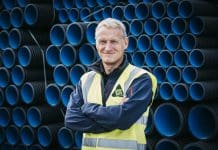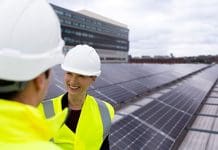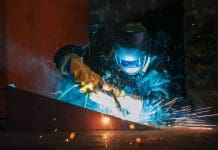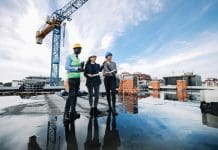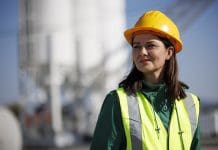Women in BIM (WIB) is hosting a one-day international conference in London on Wednesday, 22 November, to celebrate digital success across the AEC industry worldwide
The Women in BIM conference boasts a powerful line-up of influential and disruptive speakers who will share their insights and experiences on people, projects, and processes that drive the built environment’s digital future.
Ahead of the Women in BIM Conference, we met two sterling speakers from Turner & Townsend. Their trusted voices will share their insights and wisdom on technical innovation and digital transformation across the built environment on the day.
Emilia Cardamone, Associate Director, and Michael Keeley, Principal Consultant at Turner & Townsend, are on two-panel discussions, and here we ask Emilia and Michael to share their thoughts on what is happening right now in an industry that is critical for the adoption of a digital-first culture.
Welcome, Emilia and Michael. Can you briefly introduce yourselves and your experience in digital transformation within the construction industry?
Emilia: I am an Associate Director within the Turner & Townsend Digital Real Estate team. I am a construction engineer by background, and throughout my career, I have been exposed to tremendous digital topics like BIM, Smart Cities and places, Digital Carbon Management, and Digital Twins.
I am very passionate about technology and how it helps achieve better outcomes for the environment, greater user experience, and significant savings in terms of money, time, waste, and carbon.
Michael: I lead our Infrastructure Information Management as a Principal Consultant in Turner & Townsend’s Infrastructure Digital team. I’ve been responsible for the digital delivery of multi-disciplinary infrastructure projects across the UK and North America.
I have been involved in a wide range of digital engineering, from implementing information management (IM) and Analytics to GIS mapping and helping clients journey to a Digital Twin.
I am passionate about the holistic approach to digital combining people, process, and technology – I would argue people and collaboration are the most critical components!
What are some key digital trends you’ve observed recently? And how are they driving digital change?
Emilia: One thing I am passionate about is Digital Twins. I am part of the Advisory Group for the Digital Twin Hub.
I am amazed by our progress in this area and see great projects coming together, like the Climate Resilience Demonstrator (CReDo) initiative. We are not 100% there in the Built Environment sector, but there is an excellent collaboration between stakeholders, including opening discussions with other industries.
Another exciting trend is the Internet of Things (IoT) and its application. It’s fantastic to see how on-the-ground sensors, which provide live data, are driving better results across the whole asset lifecycle of a building.
Through their application, we can now understand how spaces and projects perform, which allows us to make better decisions to create better outcomes for users and the environment.
For example, by using sensors, we can monitor occupancy levels and energy usage – this means we can tailor energy use to occupancy levels, significantly reducing operating costs and consistently lowering carbon emissions.
Michael: An exciting innovation everyone knows is Artificial Intelligence (AI) and how it can support construction. Construction projects face a lot of unpredictability (e.g., from assembly costs); therefore, one of the potential uses of AI is that it can help provide clarity across everything we do – it’s very much in its infancy in our industry.
Still, it has exciting potential applications for everything, from managing contracts to optimising scheduling and better understanding the carbon emissions of materials.
Another trend often overlooked by new innovations, but I think it is essential to mention, is that systemisation is becoming increasingly common in day-to-day projects. Where previously spreadsheets dominated everything on projects (and are still dominant), database-backed systems are becoming more prevalent as standard to manage things like cost and risk, information delivery plans, or bills of quantities.
This is great because it means we are doing the basics right – so data is becoming more structured and standardised. Projects are experiencing more collaboration and improved accessibility to information. This leads to more efficiently delivered projects and better outcomes for sustainability.
What are the most significant challenges companies are facing when it comes to implementing digital transformation initiatives?
Michael: Getting the foundations right with standardised, structured data is fundamental. Companies are often drawn to procuring the leading software and spend millions on the best systems to ‘do’ digital. Still, ultimately if the data going into the system is unstandardised and unstructured, you are severely limiting what can be done. Getting the basics right and walking before you can run is often overlooked, but it is key and will unlock significant efficiencies.
Infrastructure owners and players in the construction industry are primarily huge organisations which means collaboration can be tricky – breaking down siloes and upskilling people at all levels is vital.
A combined bottom-up and top-down approach is critical – recruiting and upskilling people in areas such as data analytics is essential, but engaging senior leaders who are ultimate decision-makers drives change from the top.
What emerging technologies do you think will have the most impact on the construction industry in the next five to ten years?
Emilia & Michael: Machine Learning is on the horizon, followed closely by Artificial Intelligence. Currently, it’s being used in small pockets, but over the next five years, usage will rapidly expand across the industry.
Smart data capture and IoT can not be ignored. We cannot overlook the widespread use of integrated BIM and GIS – combining 2D and 3D visualisations—and integrated cyber-physical infrastructures and digital twins.
Women in BIM support individuals and businesses globally in their understanding and uptake of digital working methods; how important is it to you to be part of this support network?
Michael: It is critical to enhance awareness and share our knowledge and different experiences across the industry to bring about industry-wide change.
Emilia: It is very important! I have been proudly part of the Women in BIM network for a few years, and I can tell it is making a difference. The world is transforming rapidly and digitalisation can help make it a better place. We should all embrace the change and ensure no one is left behind.
Emilia is taking part in the We own the future, pushing the boundaries of technical innovation panel discission at 10:15 and Michael is on the panel for Digital Transformation in action: the future of the digital twin at 13:30.



